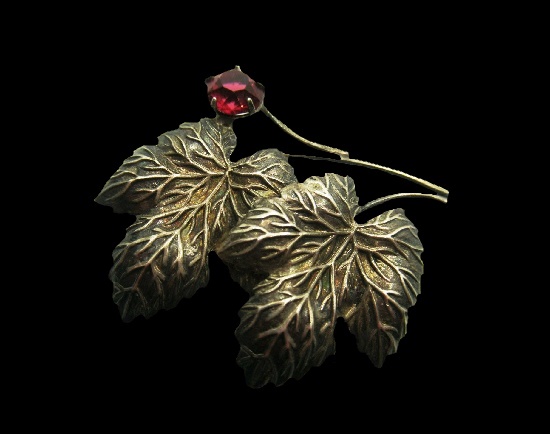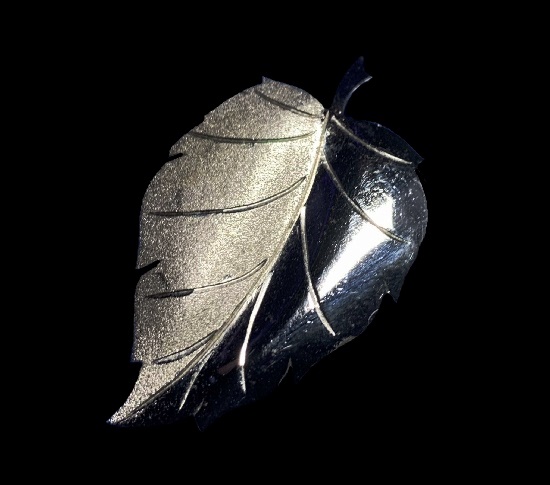
Symbolic thistle flower brooch. Sterling silver, art glass. 1960s. Ward Brothers vintage costume jewelry
Ward Brothers vintage costume jewelry
The history of the Scottish jewelry brand “Ward Brothers” began in the late 19th century in Glasgow. Handcrafted from sterling silver in Celtic, Victorian and Scottish style, the pieces had a symbolic meaning. For example, the Lucky Heather and Horseshoe designs were worn to attract good luck and success. Another traditional design is the thistle, an element of the Scottish coat of arms, symbolizing tenacity, tenacity, and resistance. According to belief, a thistle ornament is a powerful talisman that protects a person from damage and the evil eye.
Made with great craftsmanship, the company’s jewelry became very popular, and as a result, the company expanded its business. So, jewelry production began in Edinburgh and then in Birmingham. Traditionally, the craftsmen of this brand made jewelry from sterling silver, as well as using gold plating. Also, they used both natural stones – Scottish agate, and glass imitations of ruby, amethyst, zirconium and garnet.
Noteworthy, the markings on the back of the items differ, according to the year and place of production of the jewelry. In particular, the initials WBS, also the anchor mark of Birmingham, followed by the lion, and the year; the purity of gold or silver; Chester 1921 (for Ward Brothers); thistle with towers and letter B. The company ceased to exist in the 1970s and became the property of another British brand that still specializes in Celtic, Irish and Scottish style jewelry.

Stug circle pin and earrings. Textured thistle patterns sterling silver, paste citrine. 1953

1950s signature
Ward Brothers vintage costume jewelry

Symbolic thistle flower brooch. Sterling silver, citrine

1966 sterling silver leaf brooch. 4 cm

Amethyst glass cabochons round shaped brooch pin

Axe and thistle brooch. Sterling silver, carnelian, bloodstone, citrine. 1950s

Bird pendant. Sterling silver, blue stones

Bow brooch. Textured engraved sterling silver. 1962

Cameo brooch. Carved shell, sterling silver. 1920s

Victorian design silver brooch

Crowned heart brooch. Sterling silver, amethyst

Currant leaf and berry brooch. Faux garnet, textured sterling silver. 4 cm. 1950s

Signature

Eight-pointed star inside circle vintage brooch pin. Gold tone metal alloy, diamond cut crystal. 3.8 cm. 1950s

Filigree floral design brooch. Sterling silver, clear and blue crystals. 5.2 cm. 1930s

Flower design brooch. Sterling silver, citrine, Scottish agate. 1959

Hallmarked Glasgow 1949 amethyst thistles sword brooch. Engraved sterling silver

Hilda name series Victorian brooch. Sterling silver. 1899 Chester marked. 4 cm

Horseshoe Victorian brooch. Rosegold and silver. 1894

Leaf sterling silver pin. 1965

Maple leaf sterling silver green stone brooch

Ornamental round shaped sterling silver agate brooch

Parrot circle pin. Sterling silver, enamel. 3.5 cm

Paste citrine double ended floral design bar brooch. Gold plated metal. 7.5 cm

Scottish Kilt brooch. Celtic pattern engraved sterling silver, pink quartz

Scottish stug circle pin and earrings. Textured thistle design sterling silver, amethyst. 1950s

Signature

Spider bar brooch. 9 K gold, silver, blue topaz. Marked Chester 1921

Stug circle pin and earrings. Textured sterling silver, amethyst glass. 1953

Symbolic thistle flower brooch. Sterling silver, citrine

Thistle circle pin. 925 Sterling Silver, amethyst glass. 3.5 cm

Three thistle brooch. Sterling silver, amethyst glass

Two textured sterling silver leaf brooch. 1970

Victorian design sterling silver multicolor crystals brooch. Early 1900s

Viking ship circle pin. Sterling silver. 1960s

Yellow glass cabochon sterling silver thistle circle brooch

Signature











































